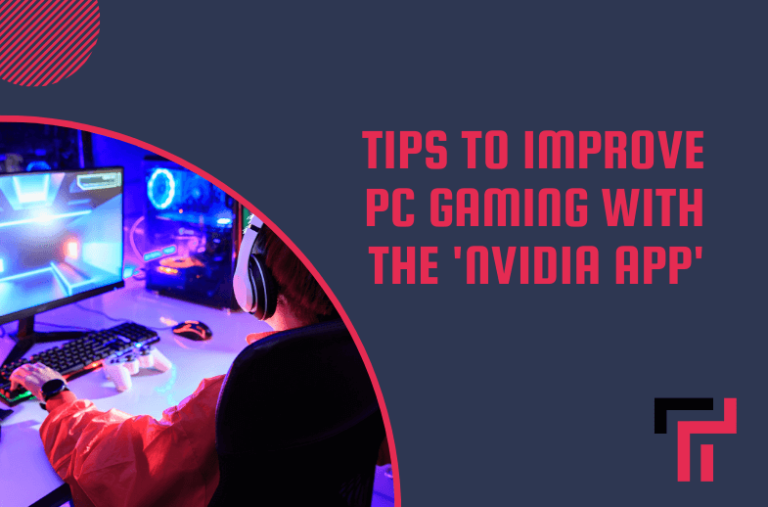Embarking on a journey into the immersive world of PC gaming demands more than just a powerful rig. It requires finesse in optimization and performance tweaking. One tool that has become indispensable for many gamers is the Nvidia app because it offers powerful utility features to improve your gaming experience. From streamlining graphics settings to real-time performance monitoring, the Nvidia app empowers gamers to unlock the full potential of their hardware. This blog post will explore a comprehensive guide on leveraging the Nvidia app effectively, providing expert tips to enhance every aspect of your PC gaming journey.
PC Gaming With the ‘Nvidia App’
Gamers are undoubtedly familiar with the renowned “NVIDIA” brand, standing tall as the leading GPU manufacturer. Yet, their influence extends beyond hardware, offering robust software support that enhances graphics card functionalities and elevates gameplay experiences. Here, we provide invaluable tips for optimizing PC gaming performance with Nvidia App:

Update Your Graphic Card
First, confirm that you’re running the most recent graphics driver. To update your NVIDIA graphics card driver, simply head to Google and search for NVIDIA drivers. Click on the link that directs you to NVIDIA.com. Once on the webpage, navigate to the manual driver search section. Select your GPU’s product type and series, and input your specific GPU product model. Specify your operating system, preferred language, and download type. After inputting these details, click “search.” Among the results, locate the GeForce Game Ready Driver and start the download. Once the download is complete, open the software containing the newly downloaded driver and select “OK” to extract it. You’ll then have the option to install only the graphics driver or include GeForce Experience. This choice avoids additional software running in the background, potentially burdening an older PC and impeding performance.
Build an All-in-One Launcher
Nvidia has crafted GeForce Experience as your comprehensive game and app launcher. While alternatives like GOG Galaxy and Steam allow you to gather games from diverse sources and tailor them as you wish, Nvidia’s approach excels in compatibility. GeForce Experience lets you quickly see which games support popular Nvidia features like Freestyle and Ansel. Moreover, it’s a convenient tool for swiftly adjusting in-game preferences or seamlessly launching games with settings tailored to your setup. In this scenario, navigate to the Graphics tab and access the three-dot menu. Opt for the Refresh option to prompt the app to recheck or manually add a title by selecting Add a program.
Unleash Your Inner Artist
The rise of in-game photo modes has been notable in AAA PC gaming. However, Nvidia has offered a solution that circumvents reliance on these game-specific features. They introduced Ansel, a game-agnostic photo tool integrated into the Nvidia app. Press Alt-Z while playing a supported game to activate photo mode to bring up the Nvidia Overlay. You can access various options like recording gameplay, instant replays, screenshots, and photo mode. Within photo mode, users can apply filters and capture high-quality photographs with features like super-resolution, 360-degree, HDR, and stereo capabilities, akin to professional-grade photography.
Read Also: Online Gaming Review Sites You Can Trust
Enable Statistics for a Performance
Another handy aspect of the Overlay is its optional Statistics display, offering many tools and information accessible without needing to tab out. Simply press Alt + Z to summon the overlay, where you’ll find a range of available tools and data. From swiftly recording gameplay to capturing screenshots or initiating broadcasts, the overlay streamlines these tasks. Moreover, it grants access to a panel showcasing performance-monitoring data. Within this panel, you can observe the impact of running a game at your current settings on your system, including details such as GPU temperature, voltage, fan speed, and CPU utilization.
Enable Automating Tunning
You also have the option to activate Automatic Tuning in the Performance panel within GeForce Experience. This feature allows your hardware to be automatically optimized for enhanced performance. It leverages the company’s Latency and Display Analysis Tool (LDAT) to assess input latency, a critical factor for gamers in fighting games or competitive online multiplayer titles. You can easily toggle the Statistics screen on and off by pressing Alt-R at any time. However, enabling this feature permits the software to overclock your GPU and CPU, which could pose risks if voltage and temperature aren’t closely monitored.
Use Image Scaling to Squeeze Out
Nestled within the Graphics menu’s Global Settings tab lies an additional option aimed at maximizing your game’s frames per second as possible from your games in the form of Image Scaling. This function enables rendering games at reduced resolutions and upscaling them, resulting in crisper visuals with minimal performance overhead. Within the Image Scaling panel, you can select your desired game resolution and fine-tune image sharpness using a slider. While not as feature-rich as Nvidia’s DLSS technology, it boasts broader compatibility by eschewing the need for specialized hardware or SDK integration.
To Sum Up
Leveraging the Nvidia app is a game-changer for enhancing your PC gaming experience. From updating graphics drivers to unlocking advanced features like Ansel and automatic tuning, each tip discussed in this guide contributes to optimizing performance and elevating visual fidelity. By harnessing the power of the Nvidia app, gamers can fine-tune their setups, monitor system performance in real time, and easily capture breathtaking moments. Whether you’re a seasoned enthusiast or a newcomer to PC gaming, integrating these tips into your gaming routine will undoubtedly lead to a more immersive and enjoyable experience.







